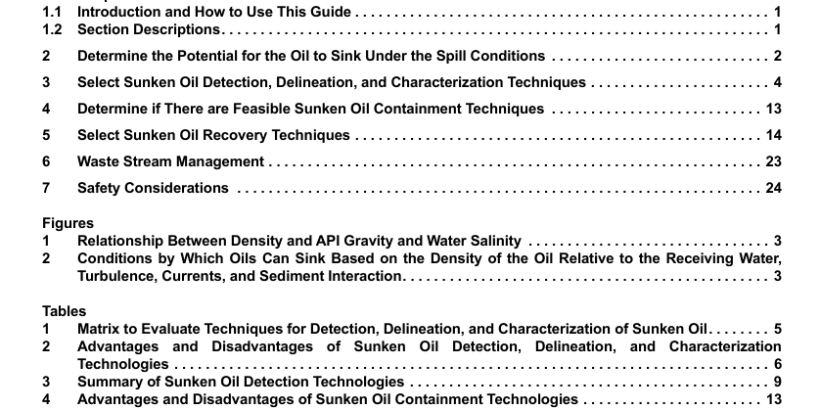API TR 1154-2:2016 pdf free download.Sunken Oil Detection and Recovery Operational Guide
This Operational Guide is a companion document to the technical report, Sunken Oil Detection and Recovery, which identifies and documents current best practices and alternative technologies possessing the potential to more effectively detect, contain, and recover sunken oil, defined as the accumulation of bulk oil on the bottom of a water body. The technical report includes summaries and lessons learned for 36 case studies of oil spills where a significant amount of the oil sank. For each technology, it includes a detailed description of the method, advantages and disadvantages, and summary tables—the kinds of information needed to select the most effective approaches to sunken oil detection and recovery. Please refer to the technical report for supporting information not in this guide.
Most oil spill response strategies, tactics, and equipment are based on the simple principle that oil floats. However, oil does not always float. Sometimes it suspends in the water column; sometimes it sinks to the bottom of the water body. Sometimes it does all three: floats, suspends, and sinks. Furthermore, oil that has sunk to the bottom can become re-suspended and spread by currents. Terminology to describe these various behaviors can be confusing; thus, in this guide, the following terminology is used.
— Floating oil—Spilled oil that is on the surface of the water.
— Submerged oil—Spilled oil that is in the water column, below the water surface, including oil that is in temporary suspension due to turbulence and will refloat or sink in the absence of that turbulence.
— Sunken oil—Spilled oil that is on the bottom of the water body. This guide addresses only sunken oil.
1.2 Section Descriptions There are six subsequent sections to this guide.
— Section 2: Determine the Potential for the Oil to Sink under the Spill Conditions This section provides guidance on when to expect that an oil may sink, either initially or later due to processes such as weathering and sediment interactions. It includes a chart to help determine if an oil can sink initially based on its density or API gravity and the salinity of the receiving water. It also includes a chart that shows how turbulence and sediment interaction can cause a floating oil to submerge or sink over time.
— Section 3: Select Sunken Oil Detection, Delineation, and Characterization
Techniques This section includes a checklist of the types of information you will need about the oil and spill conditions to start evaluating which sunken oil detection options may be effective for the spill. There is a list of action items to guide the development and approval of a sunken oil detection plan. It also includes tabular summaries of the advantages and limitations of possible options, along with a matrix to guide selection of the best combination of options.
It is important to note that oftentimes multiple detection, delineation, and characterization methods should be used, in combination and/or in sequence. All remote detection methods require ground truthing or need bottom sampling to determine the oil thickness on the bottom or determine the oil’s viscosity and thus pumpability.
— Section 4: Determine if there are Feasible Sunken Oil Containment Techniques This section notes that containment of sunken oil may not always be feasible. It includes summaries of the advantages and limitations of possible options under mostly low-flow conditions.
— Section 5: Select Sunken Oil Recovery Techniques
This section includes a checklist of the types of information you will need about the oil and spill conditions to start evaluating which sunken oil recovery techniques may be effective for the spill. There is a list of action items to guide the development and approval of a sunken oil recovery plan. It also includes tabular summaries of the advantages and limitations of possible recovery techniques, along with a matrix to guide selection of the best combination of techniques.API TR 1154-2 pdf download.API TR 1154-2:2016 pdf free download
